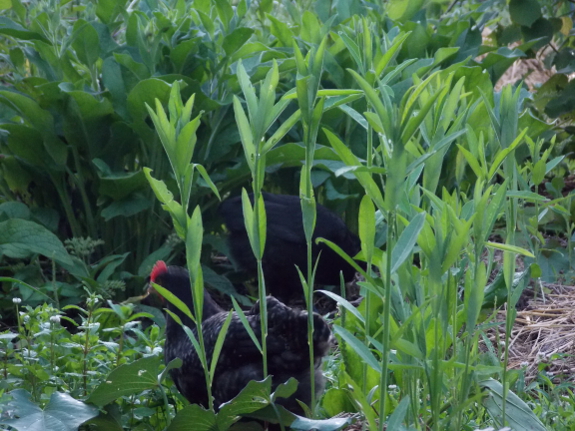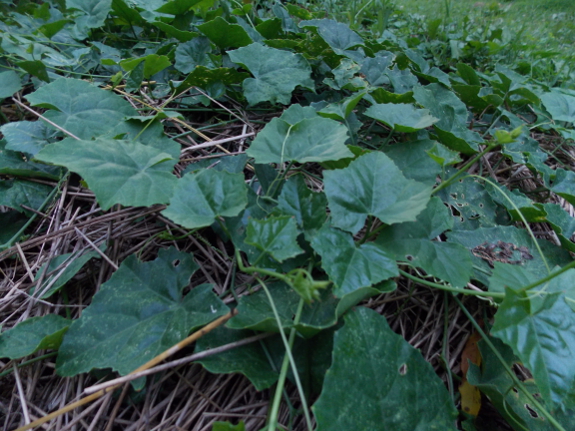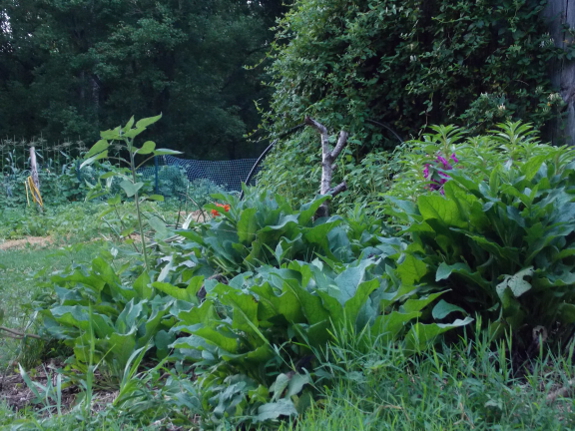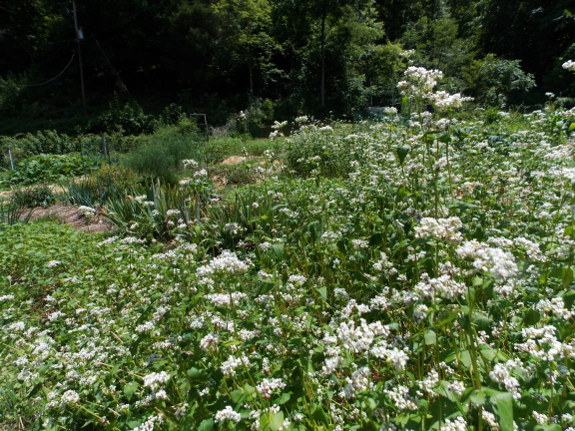
Experimental summer cover crops

I've been trying lots
of cover crops this year, and even though the results aren't in, I
thought I'd write a midterm sum up. The image above is from
the forest garden, where I planted sunn
hemp (the tall
things in the foreground), sunflowers, and sweet potatoes as cover
crops in the last few weeks.
The sunn hemp is
growing great in good soil, but is struggling (as most things do)
in poor soil with high groundwater. The sweet potatoes seem
to be doing well everywhere, and have the major bonus that I can
plant a single set and then expect it to grow exponentially
despite the troublesome trio of chicks who have been roaming the
garden lately. The sunflower seeds, I'm sad to say, all went
down those chicks' gullets. (More on the drama of the chicks
coming up over on our chicken blog.)

Even though I put it
in as a vegetable, I'm now considering this perennial
cucumber (sent to us by a kind reader) to be a cover
crop. Despite its name, the plant has yet to fruit for us,
probably because it doesn't like living in the land of all rain
and no sun. I won't repeat this experiment since it's not
worth keeping a cutting over the winter just for biomass
production, but the cucumber does seem to be covering bare soil
well (and also growing up into my trees).

Although not a cover
crop, I thought I'd show you my comfrey bed, turned flower
garden. Last winter, I
ripped out every single plant and root I could find to
transplant to a chicken pasture, but of course the comfrey
came back with a vengeance from the root fragments left
behind. I ripped the new plants back to the ground once this
spring and planted annual flowers in the gaps, then ripped the
comfrey back again to give those flowers a chance to bloom.
Looks like I'm due for another ripping job. The nearby plum
trees are enjoying their monthly doses of comfrey mulch.

In the main vegetable
garden, I'm playing it safe and just filling gaps with my trusty
standby --- buckwheat. The bees (wild and cultivated) adore
the flowers, and it's always a joy to pull up buckwheat just
before planting time. I end up with free mulch to cover
perhaps a quarter of the bed, along with nearly weed-free ground
for my seedlings to enjoy. While the other cover crops
mentioned in this post are experimental play, the buckwheat is tried
and true.
Want more in-depth information? Browse through our books.
Or explore more posts by date or by subject.
About us: Anna Hess and Mark Hamilton spent over a decade living self-sufficiently in the mountains of Virginia before moving north to start over from scratch in the foothills of Ohio. They've experimented with permaculture, no-till gardening, trailersteading, home-based microbusinesses and much more, writing about their adventures in both blogs and books.
Want to be notified when new comments are posted on this page? Click on the RSS button after you add a comment to subscribe to the comment feed, or simply check the box beside "email replies to me" while writing your comment.

Anna,
As usual, really enjoying all you are up to with your reading, writing, experiments and gardening projects. How you find the time, I am not sure.
I just recently purchased another of your ebooks, "Homegrown Humus" and have found it to be extremely interesting and useful. I have started sourcing some of the seeds for your big three cover crops. Oats are not a problem. Buckwheat is available, but the $16 price you quote is miles away from what I have found here in NC. The local feed store is asking $45 and Southern States wants $75. To verify, I have looked online and found prices at >$50 plus shipping. Where are you getting $16 Buckwheat.
As for the radishes, I am not finding them at all. Dakon are available but not Tillage. Any suggestions on sourcing?
Thanks!
Tim Martin MartinFarm
Tim Martin --- Good questions. I suspect being able to get cheap buckwheat locally is dependent on what the nearby farmers use as cover crops. If enough buy buckwheat that the feed store can get it in bulk, the prices go way down. We get ours at various local feed stores, all of which seem to keep that low price for both oats and buckwheat, but they aren't chains, so I can't point you into a direction that's local for you. (Also, I bought our yearly 50 pound bag several months ago, so it's possible there's now some shortage that's driving up prices that I don't know about.)
I've been getting my oilseed radishes from Johnny's (http://www.johnnyseeds.com/p-5813-oilseed-radish.aspx). It's nowhere near as cheap as the cover crop seeds I can get locally, though, partly because shipping is very costly, and also (I suspect) because oilseed radishes are still a bit more trendy. I haven't decided yet if they're worth the extra cost compared to oats, but we have half of a 25 pound bag left from last year, so we'll planting them again this year at least.